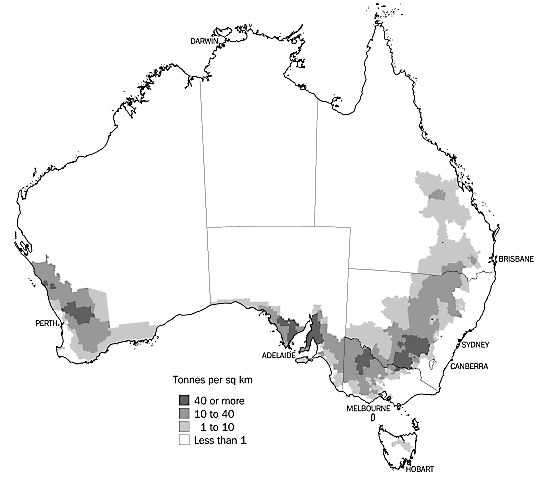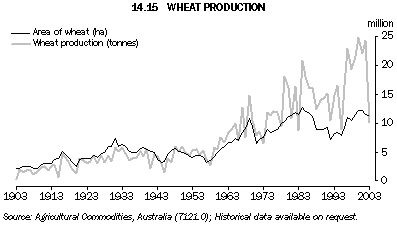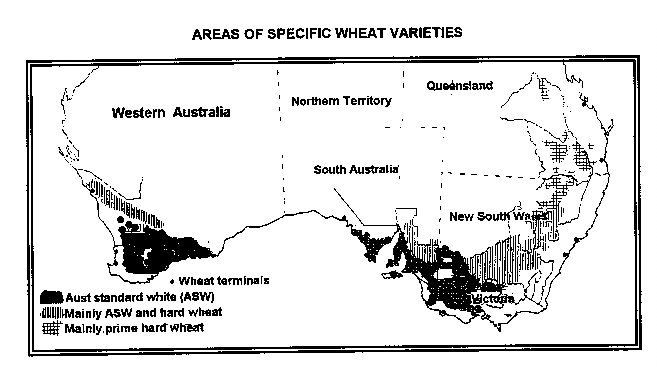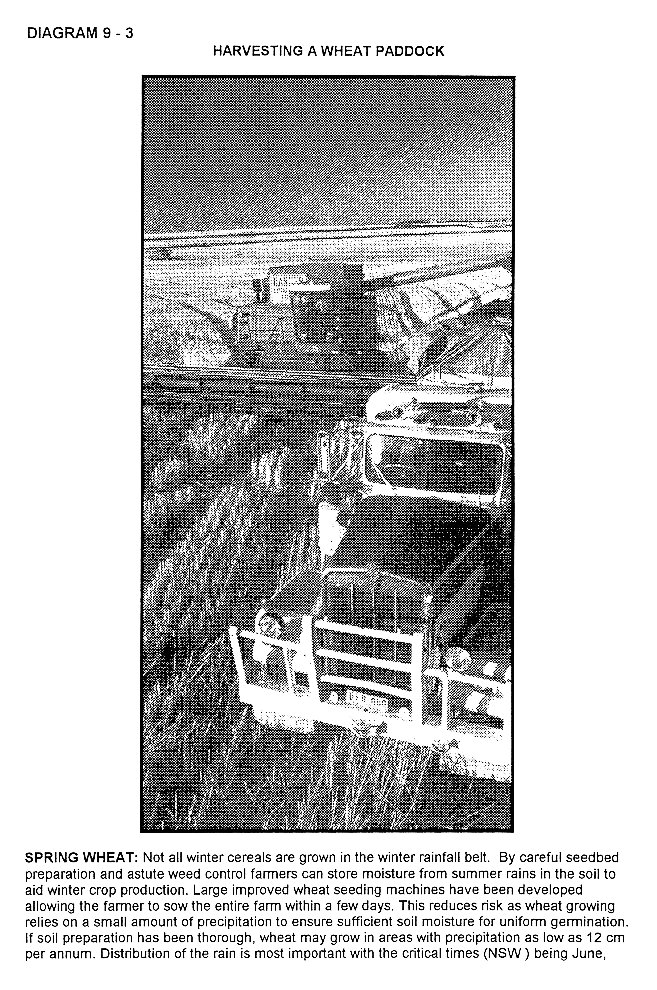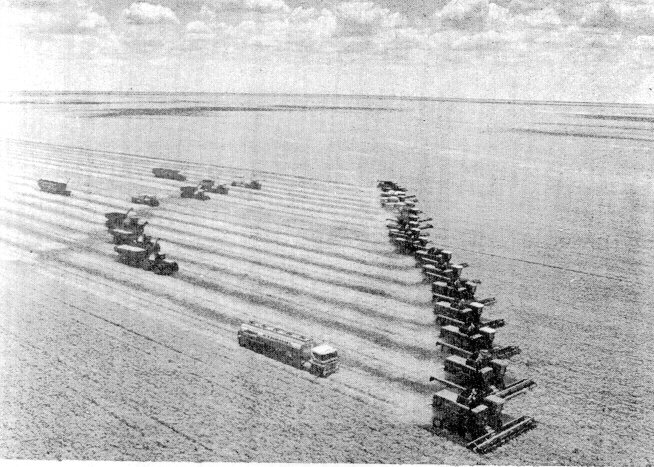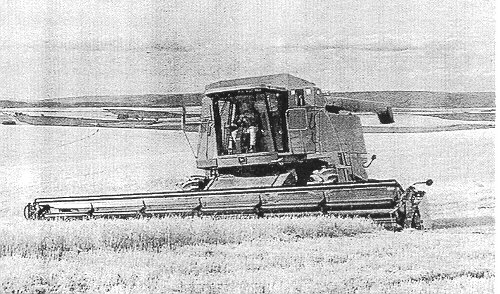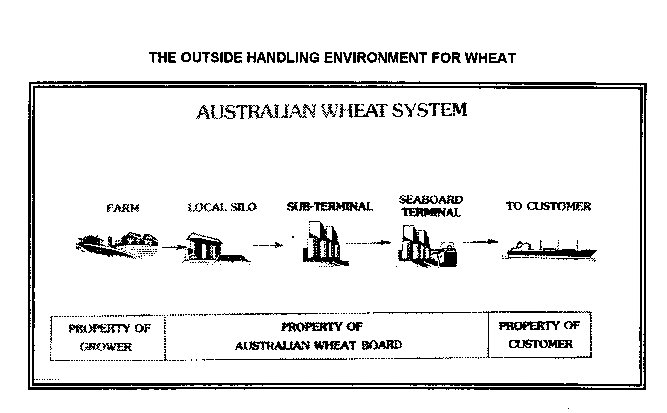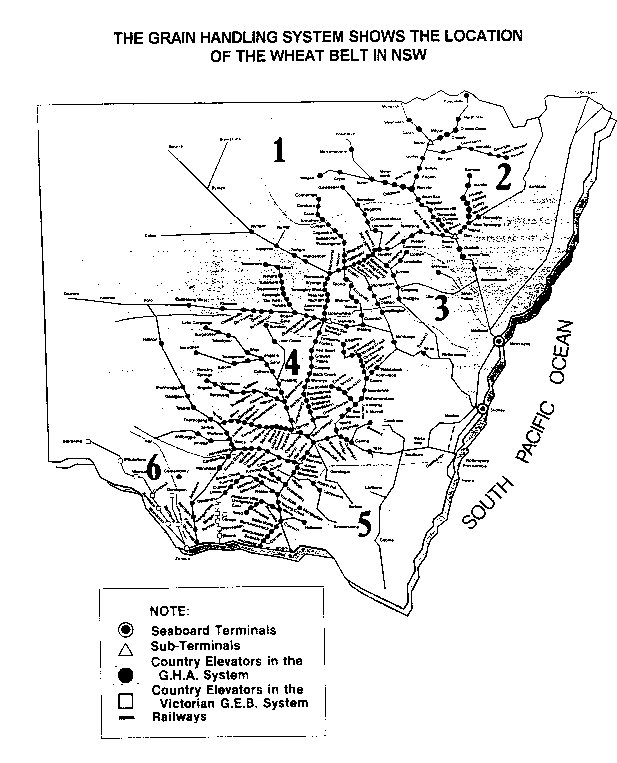WHEAT
Wheat
is Australia's largest crop. It is produced in all States but
primarily on the mainland in a narrow crescent known as the wheat
belt. Inland of the Great Dividing Range, the wheat belt stretches in
a curve from central Queensland through New South Wales, Victoria and
southern South Australia. In Western Australia, the wheat belt
continues around the south-west of the State and some way north,
along the western side of the continent (see diagram 1).
DIAGRAM
1: WHEAT FOR GRAIN PRODUCTION IN AUSTRALIA 1996-97
Final
estimates for the 1999-2000 season show that wheat production
increased by 15% over the 1998-99 season to a record 24.8 million
tonnes (table 3). New South Wales recorded the biggest increase in
production, up by 31% to 8.6 million tonnes, followed by Victoria
which was up by 81% to 2.6 million tonnes.
Western
Australia remained the biggest producer of wheat with a record State
harvest of 9.0 million tonnes.
Severe
drought across Australia more than halved wheat production to 10.1m
tonnes in 2002-03. The main falls occurred in NSW where production
fell by 69% to 2.5m tonnes and WA where production fell by 48% to
4.0m tonnes. The table below shows that variability in wheat
production is part and parcel of the life of the wheat farmer with
significant falls in production about every 10 years over the past
100 years.
TABLE
3: WHEAT FOR GRAIN, AREA AND PRODUCTION AREA
('000 ha.)
| YEAR |
NSW
|
VIC |
QLD
|
SA
|
WA
|
TAS.
|
AUST |
| 1994-95 |
1,424
|
822
|
401
|
1,395
|
3,848
|
1
|
7,891 |
| 1995-96 |
2,328
|
853
|
627
|
1,519
|
3,892
|
1
|
9,221 |
| 1996-97 |
3,192
|
963
|
980
|
1,535
|
4,264 |
2
|
10,936 |
| 1997-98 |
2,936
|
857
|
1,001
|
1,438
|
4,205 |
3
|
10,441 |
| 1998-99 |
3,174
|
949
|
1,139
|
1,762
|
4,515
|
4
|
11,543 |
| 1999-00 |
3,425
|
1,235
|
1,096
|
1,850
|
4,556
|
6 |
12,168 |
| 2000-01 |
3
671
|
1 143
|
885
|
1 976
|
4 460
|
7
|
12 141 |
| 2001-02 |
3
446
|
1 136
|
604
|
1 987
|
4 350
|
6 |
11 529 |
| 2002-03 |
2
995
|
1 239
|
514
|
1 957
|
4 458
|
7
|
11 170 |
| PRODUCTION
('000 t) |
|
|
|
|
|
|
| 1994-95 |
875
|
934
|
225
|
1,487
|
5,438
|
3
|
8,961 |
| 1995-96 |
4,508
|
1,921
|
519
|
2,724
|
6,827
|
4
|
16,504 |
| 1996-97 |
8,363
|
2,262
|
1,980
|
2,795
|
7,516
|
8 |
22,925 |
| 1997-98 |
5,906
|
1,503
|
1,392
|
2,689
|
7,725
|
12
|
19,227 |
| 1998-99 |
6,563
|
1,462
|
1,941
|
3,310
|
8,170
|
18
|
21,465 |
| 1999-00 |
8,602
|
2,642
|
1,904
|
2,586
|
9,004
|
20
|
24,757 |
| 2000-01 |
7
867
|
3 080
|
1 157
|
4 162
|
5 814
|
26
|
22 108 |
| 2001-02 |
8
043
|
2 791
|
901
|
4 778
|
7 760
|
25
|
24 299 |
2002-03
|
2
495
|
890 |
601
|
2 072 |
4 047
|
25
|
10 132 |
Source:
Agricultural Commodities, Australia (7121.0).
Wheat
is a popular cash crop because it has a reliable export market and a
price support system. However, it is often rotated with other cash
crops for example, oats which provide fodder for conservation.
Australian wheat production has long been characterised by high
production per man hour and low production per hectare. The area of
crop per man employed is about 120 hectares for the main wheat
growing areas. This low labour ratio is a result of early
mechanization of the harvest operations and therefore, wheat
production has become concentrated in those areas best suited to farm
machinery.
The
industry has been attracted to large areas of easily cleared, cheap,
level to undulating land with soil types suitable for the operation
of large cultivating machines. Further, a dry, hot summer allows the
use of heading machinery. These have been the main considerations in
determining the location of the present cereal areas and illustrates
the importance of the technology environment on the agricultural
system. However, within the wheatbelt there are great variations in
soil type and climate.
WHEAT
VARIETIES IN SOUTHERN AUSTRALIA
A
NUMBER OF HEADERS AND TRUCKS ARE USED IN A
COORDINATED
EFFORT TO HARVEST THE WHEAT IN LARGE PADDOCKS IN WESTERN NSW. THE AIM
IS TO HARVEST AS QUICKLY AS POSSIBLE TO SAVE COSTS AND ANY
DETRIMENTAL EFFECTS FROM THE WEATHER
A
TYPICAL HEADER, HARVESTING WHEAT. WITH MINOR MODIFICATIONS
THE SAME HEADER CAN BE USED TO HARVEST CANOLAHIGH SPRING TEMPERATURES
AND HUMIDITIES
High
spring temperatures and high air moisture content in the northern
wheat belt of NSW makes rust resistance an essential characteristic
of the cereal varieties in use. However, in the southern districts,
conditions suitable for rust epidemics are not as frequent.
SOILS
Wheat
can be grown on a wide range of soils and it is doubtful if soil type
can be regarded as being greatly significant in determining the
location of cereal areas. The physical characteristics of the soil
has been investigated in great detail and it has been found that the
most desirable soil is a free working surface soil with a good
retentive subsoil. The former is important for efficient and cheap
operation of large cultivation implements and the latter controls the
amount of moisture conservation possible.
The
best loams have been farmed to cereals for over a century and have
maintained their structure and productivity. On either side of such
optimal conditions are soils which although satisfactory in the early
years of the cultivation, have subsequently become inferior in both
of these features.
For
example, sandy soils which under regular cultivation have become
liable to serious wind erosion and on the other hand, heavy clay
soils whose loss of structure has resulted in such high cultivation
costs that many have been returned to pasture.
METHODS
OF CULTIVATION
The
most outstanding factor in Australia is the fact that 50% of the crop
is sown on cultivated fallow land.
The
term fallow in this case applies to land which receives its initial
cultivation in the winter or early spring and is maintained in weed
free condition for a period of 6-9 months until the crop is sown in
the following autumn. The benefits derived from this practice are:
- conservation of
soil moisture
- accumulation of
nitrate nitrogen
- reduction of
weed competition
- promotion of
tilth
- a firm seed bed.
However,
these advantages accrue only where the fallowing process has begun
early enough to conserve the rainfall and nitrification of the
previous spring. In the more favoured districts where autumn rains
can be relied upon, the period under fallow can be reduced and the
initial cultivation deferred until February of the year in which the
crop is sown.
Such
a practice is called "short fallow" and is used quite
effectively in the northern portion of the Australian wheat belt
which receives monsoonal rains.
WHEAT
PRODUCTION IN NSW
Australia
produced 12 168 000 tonnes of wheat in 1999-00 with more than 25%
coming from NSW. There are over 20 000 wheat growing properties in
NSW few of which rely exclusively on wheat for income. All the
properties are situated within an area which extends from Queensland
to the Victorian border and is known as the wheat belt - see
diagram 2.
THE
GRAIN HANDLING SYSTEM SHOWS THE LOCATION OF
THE
WHEAT BELT IN NSW.
Because
of the climate and topography this is the only part of the state
suitable for wheat growing. The area varies from season to season but
has remained steady in recent years. – see table 3.
Some
wheat farms are owned by large companies but most are owned and
worked by private farmers with the help of modern agricultural
methods and machinery. Wheat is sown using a combination seed and
fertilizer drill drawn behind a tractor. Sowing usually takes place
between early April and late July and varies from region to region.
The
crops mature between October and December and are harvested
immediately. This is done with machines called "headers",
which strip the heads from their stalks separating grain from chaff
in the process.
The
grain is usually loaded straight from the header into lorries waiting
in the field and taken directly to a nearby storage centre operated
by the Grain Handling Authority (GHA). A small quantity is retained
on the
farm
for next year's seed and stock feed.
11
